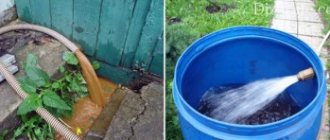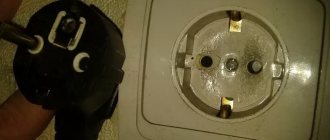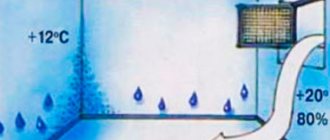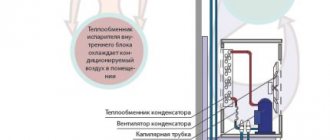Reasons for water leaking from the indoor unit
Reasons for water leakage from the outdoor unit
Dripping from the neighbor's air conditioner 
Every owner of an air conditioner encounters a leak from the housing. Dripping from the indoor unit, water damages the decorative finish of the wall, furniture, and can cause a short circuit when it penetrates the wiring. Leaking from the indoor unit, water drips onto neighboring window sills and splashes the windows. When the equipment operates correctly, the condensate formed on the evaporator should drain into a container. And from there it is led out into the street through a drainage hose. Some problems can be fixed on your own. But most faults require repair in a service center.
Why does water flow
Several breakdowns lead to the disastrous result of the air conditioner leaking. Let's look at each of them:
- In those years when the daytime temperatures do not drop below +30, the cooling system wears out. As a result, the container where the condensate collects becomes overfilled and it flows out.
- Don’t think that problems with a split system can only arise in the summer. Problems also occur during cold weather. During freezing, the heat exchanger becomes covered with ice, causing condensation to appear on the housing. Basically, freezing occurs when there is a significant difference between degrees at night and during the day.
- The reason why water drips from the air conditioner into the room may also be a broken drainage. As a result, condensate flows in, although it should go out.
- A leak may also occur due to the drain hose being positioned incorrectly. Accordingly, the liquid changes direction.
- A depressurized circuit can also result in troubles and additional expenses. The result may be weakened pipes through which the liquid functions within the system. In this case, water will not flow in a stream, but condensation will be visible on the body.
The accumulated condensate is immediately visible Source antares-48.ru
- And finally, the cause of the leak may be increased pressure inside the circuit. This reason is quite serious, and there is no point in trying to deal with it without the necessary tools and knowledge.
See also: Catalog of companies that specialize in engineering systems
Broken or broken connections
There is usually a pipe between the drain hole of the tray and the drainage tube. Sometimes it can crack, break off or fly off the tubes. This is a flexible hose that is held on with clamps or latches.
Open the air conditioner cover and look on the right and left sides (depending on the installation option) at the condition of the pipe. If the problem is in it and it is from it that water flows, it needs to be changed.
Solution
Don't look for an original pipe - you'll just waste your money . At any plumbing store or market, buy one of the same diameter and secure it with ordinary plastic zip ties.
If the old pipe was secured with clamps, wrap them or the pipe itself with fum tape. Then put on a new one.
Air conditioner drain pipe in the indoor unit.
Water flows from the air conditioner into the room - what to do
So, let's look at the causes of leaks from the air conditioner and solutions. Of course, it is best to call a specialist to your home, but you can perform some actions yourself:
- If we are talking about the first reason, then a master may not even be needed here. It is enough to pour out the excess liquid from the drive, insert it into its original position, after which the equipment will work properly again. It is important to turn off the power first. In the future, also do not forget to monitor the slightest leak.
- One of the reasons why the air conditioner leaks is the result of the appearance of ice - it makes sense to make thermal insulation. For example, to avoid temperature changes, you can use glass wool.
- If the cause of the breakdown is the pump, it should be repaired, if possible, or replaced. It is difficult to do this without proper experience, so it is better to turn to the experts.
- If the corrugated hose is positioned incorrectly, it is enough to place it at the correct angle.
- The pipes can be strengthened if it is better to tighten them with nuts and finally use sealant for processing. It is important to act delicately here so as not to break the thread.
Even if the split system has been repaired, do not forget to monitor it so that there are no unnecessary accumulations in it, and in the future it will no longer leak. Prevention is always very important in the case of air conditioners.
Repair of air conditioners in case of leakage in the apartment Source www.stroiword.ru
Where to buy a replacement
While repair work is being carried out, a portable air conditioner can be a temporary replacement for a stationary product. It can also come in handy at the dacha, or, for example, when traveling somewhere to visit. The best option in terms of price-quality ratio is to purchase from the AliExpress online store. Mandatory long waits for parcels from China are a thing of the past, because now many goods are in intermediate warehouses in destination countries: for example, when ordering, you can select the “Delivery from the Russian Federation” option:
| Tabletop mini air conditioner 1100 W for home, USB charging | Mini humidifier, air conditioner | Desk Fan, Humidifier, Purifier |
| Portable air conditioner, humidifier | Air Conditioner, Humidifier, Portable Purifier for Home | Air conditioner 1100W with timer, cooling/heating, remote control |
The air conditioner leaked into the apartment - what experts advise
Experts say that the most common cause of a leak is a clogged drainage tank. Therefore, if you do not carry out periodic cleaning, then at some point one of the pipes will simply become clogged. Any debris can get into the tubes, especially in summer, from grass to insects. Some of them, attracted by water, even settle inside the split system. Some owners of this equipment even put a special fine mesh on the end of the outlet pipe, but we should not forget that this too can become clogged over time.
Cleaning the air conditioner if it leaks Source mamamoet.ru
How to deal with it
Calls for cleanliness are not enough here. There is still dust in the air, and it will definitely get inside the system. The manufacturer took care of this by installing mesh filters behind the grilles.
And these filters must be kept clean. At the end of the season, or best of all, once a month, the mesh should be removed from the housing, washed and dried. In addition, the radiator heat exchanger (fins) must be washed periodically. If the drainage is not clogged, dirty water will easily drain out.
Likewise, it is necessary to clean the fan turbine. The same dust gets on the blades, and it can lead to vibrations and damage.
The condensate collection tray itself is an excellent garbage pit. Heavy dust particles settle to the bottom and serve as an excellent preparation for the formation of a blockage at the entrance to the drainage. Again, the inside of the hull needs to be cleaned before the season begins.
Prevention of the drainage system
Without waiting for a flood from the indoor unit, it is necessary to regularly clean the tube connecting both air conditioner modules. To do this, you can use a tool to remove blockages in the sink, an enema (creating water pressure), or a pump for a beach mattress. To check the drainage patency, pour a glass of water into the condensate tray. The liquid should disappear within a few seconds.
Check the condition of the external parts of the drainage. If the flexible tube outside the wall is dangling in the wind, secure it.
Before the start of the season, be sure to check the tightness of the drainage connection with the outer tube. A couple of meters of sealed film costs a penny, unlike damaged wallpaper on the wall.
Air conditioner repair prices - why cheap installation is not profitable
Often, the cause of breakdowns due to which water flows inside is cheap and at the same time poor installation. Thanks to it, the causes of malfunctions can be the following:
- The hole made for the tube is not made at an angle, as is customary, but straight, which is why condensation will soon begin to flow inside.
- If low-quality materials were used during the installation process, the tube may break. Also, in a hurry, the master himself can break it.
- Also, poor rolling can lead to a disastrous result, due to which freon leaks, and then, as a result, the heat exchanger freezes. As a result, when the split system is turned on, melted liquid flows and ice falls out.
- The freon line was poorly insulated. This is not only a condensate leak, but also the need for an urgent replacement of freon.
Shall we clean the pipes?
Often the cause of condensation leaking from the air conditioner is a clogged drain pipe. This can be easily determined by eye.
Turn off the air conditioner and open the lid. If there is not a lot of dirt in the tray and the pipe is in good condition, the water should go down the drain. If there is water standing in the container, it means the drainage is clogged. You need to “break through” the resulting traffic jam.
Getting rid of the blockage
To clean the drain tube, disconnect it from the container. Just don’t forget to place a bucket or basin, otherwise all the water from the tray will be on the floor and walls... To clean the drainage, you need a regular electrical cable. It should be soft enough that it can be bent with little effort.
Insert the end of the cable into the drain tube and push into it until you feel it hit something. Congratulations, you've found the traffic jam! Now it needs to be broken through. To do this, “knock” on the plug until the cable goes further. But that is not all!
Most likely, you only made a small hole in the clog. Pull out the wire completely and wrap the end with cloth. It is advisable to secure it with tape or tape. Soak the cloth in detergent and clean the drain tube thoroughly.
Options for solving the problem
As soon as you notice that water has started to flow, immediately disconnect it from the power supply. You can clean the drainage tube yourself. To begin, take a medium-thick wire and make a small hook. Then carefully insert it into the drainage tube and push it forward with rotational movements.
From time to time, take it out and clean it. If you feel that the wire is resting against something, then the reason is a blockage. Thanks to the pre-formed hook, you can easily reach any midge. In addition, you should clean the condensate tank, bath, and filters from bacterial contamination using special products.
Professionally, I use steam cleaning, which will deal with bacteria and germs. Steam is supplied under pressure through a special pipe
If there is icing, you should wait until the ice melts on its own. Then contact the master. After such an express cleaning, you can also carry out a general cleaning.
To do this, you need to disassemble the indoor unit. Using a screwdriver, remove the drain pan, then attach a high-pressure washer (water hose) to the drain pipe and rinse for 5-10 minutes. If you find that the problem is due to unprofessional installation, then you should call specialists.
To prevent breakdowns, you should regularly carry out technical cleaning of the air conditioner, which consists of washing the filters and drain pipe. In warm weather, climate control equipment must be cleaned once every 2 weeks. From time to time you should check the condensation level of the split system.
An effective way to check the condition of the strainer is to spray it with a thin stream of clean water.
Now you know, if water flows into the apartment from the split system, you should immediately disconnect the device from the power supply. Then you need to check the condition of the air conditioner. And if, after all our recommendations, water is still dripping, then immediately call a specialist.
Where to contact
If all possible options for eliminating dampness do not help, then you need to write and submit a statement to the management company. In 2021, it will be drawn up in writing and in two copies. The paper should contain detailed information about when the corners or walls began to get wet, and an exact indication of the location.
ATTENTION! After submitting your application, it is important to ensure that it is recorded. The applicant must keep one copy with a mark.
The next action of the management company should be to send a technician to inspect the residential premises, based on the results of which a report on the presence of dampness and the reasons for its occurrence will be drawn up. The apartment owner must request a copy of this document.
As soon as the act is drawn up, the management company must decide on the option for repair work, as well as the time frame by which it will be completed. It is advisable for the apartment owner to take a copy of each document. If the repairs are not carried out or the period is significantly delayed, then these copies can be contacted with the relevant authorities.
Sample application to the Criminal Code
Sample complaint to the Housing Inspectorate
Then you can file a complaint with the housing inspectorate. It can also be submitted collectively, where all participants sign and the date is indicated. Such a complaint is considered within 30 working days. However, practice shows that it is considered in a shorter period of time. Most often this happens within 14 days.
Sample application to the Prosecutor's Office
The next authority you can subsequently contact is the prosecutor's office. A complaint to this body must be made in free form. As a rule, it is filled out in an official business style.
Obscene language and the use of jargon are unacceptable. And also you shouldn’t rate the problem. You need to restrain your emotionality. The government agency has the right to leave such applications without consideration.
Another important point is that errors, whether punctuation or spelling, should not in any way affect the acceptance of the complaint. At the end there is a signature and date.
Sample application to the Court
The last authority to which you can turn is the court. It should finally resolve your problem. But most often it all ends in the previous organs.
About the main faults
It is not recommended to fix any breakdowns yourself. If you do the repair yourself, and then problems arise, the manufacturer will most likely refuse the warranty.
If there is poor cooling in the room
This is usually due to the following reasons:
- Weak power.
- The appearance of internal damage.
Sometimes it happens that the power of the air conditioner is not enough to maintain the temperature in a particular room. An example is due to a sharp change in the climate in which the operation is carried out. The average temperature range is from -7 to +40 degrees. These are the main indicators that apply to all devices.
In other situations, the problem is related to internal failures of the device. It is recommended to immediately seek technical service; it is also difficult to solve something on your own.
Short cycle unit
At first the device is turned on, but it stops working literally after 15-20 minutes.
This problem has several reasons:
- Dirty radiator.
- Failed thermostat.
- Broken control board.
- Problem with settings.
External radiators are subject to various mechanical damage and stress, especially in the summer. When foreign objects get inside, the entire system begins to overheat. Because of this, all work stops. The problem is eliminated by flushing the radiator with water and strong pressure. This will help eliminate other air conditioner problems.
After refilling, a refrigerant imbalance may occur. It is enough to measure the operating pressure of the compressor to understand how severe the problem has become. If an overload occurs, the excess liquid is simply disposed of.
Condensate leakage from the indoor unit
This is also one of the signals of faulty equipment. This may happen due to a clogged condenser tube.
The repair involves performing several simple steps:
- Turning off the air conditioner. You have to wait 10 minutes.
- Disconnecting the plastic drain tube.
- Cleaning and drying.
- Returning the structure to its original position. This often helps if the air conditioner is broken.
Recommendations
All of the above reasons are not the only ones, but are the most common in practice. To a large extent, everything depends on how well the drainage from the air conditioner was thought out and executed during its installation or laying of communications.
After completing the installation work, it is necessary to check how the drainage is proceeding. This is very simple to do, just fill a convenient container with water and carefully, without fanaticism, pour it directly onto the evaporator.
An equally important factor will be timely maintenance of the air conditioner, which should preferably be carried out at least once every 2-3 years.
If your air conditioner is leaking , just order air conditioner service!
“Equipment for Comfort” will qualitatively carry out all the necessary maintenance work on the air conditioner on-site in St. Petersburg and the Leningrad region.
Copyright © Blog “Technology for Comfort”
Ways to get rid of dampness
What to do to get rid of the problem, you need to decide on your own, taking into account the cause of its occurrence. Sometimes it is enough to ventilate the premises more often; in other cases, redesign of the heating system or radical measures are required.
Getting rid of external moisture
If you know why the base is getting wet, you need to start immediately solving the problem. Ventilation and electric heating will only partially correct the situation. It is better to take the following measures:
If you seal the seams in only one apartment, over time the problem will appear again. Joints need to be insulated throughout the house.
Restoring ventilation
If the wall of a brick house gets wet and the ventilation is not working well, then this problem can be solved in several ways. If there is a local malfunction of the structure, you just need to move the cabinet or curtains. To remove a ventilation blockage that is located near the grille, you can use a vacuum cleaner. To properly organize traction in a private home, expert advice is required.
Redevelopment of premises in brick or panel buildings on the upper floors often leads to disruption of air flows. If the draft is not normalized, then slits need to be made at the bottom of the door. This will improve air circulation.
To make damp walls dry faster, you can organize forced ventilation. The device is installed in the bathroom instead of a grille. The same device is installed in the kitchen. The fan is sometimes equipped with a timer and a check valve. The hood is checked every 3-4 months.
Elimination of high humidity
Walls can become damp due to the influence of internal factors. In the absence of insulation and poor performance of the heating system, moisture in the rooms will increase even more. To eliminate the problem, additional or alternative sources of thermal energy are needed.
If plastic windows are installed, there is insufficient ventilation in those places. Therefore, ventilation is mandatory.
Elimination of freezing
Being in a damp and cold room is not only uncomfortable, but also dangerous to your health. There are several ways to deal with the problem. The first of them is stronger heating of the room. However, its disadvantage is the increase in heating costs.
It is more effective to insulate the house from the outside. If polystyrene foam is used for work, then re-insulation from the inside is not used, since the dew point moves closer to the room. Moisture will accumulate under the insulation, which will lead to the development of fungus and mold, which will worsen the problem.
Thanks to external insulation, the dew point is in the right place. This process is expensive but effective. If internal insulation is not required, then correct thermal calculations are important, otherwise dampness will increase and the insulation material will get wet, which reduces its effectiveness. The indoor microclimate is deteriorating.
If the thickness of the walls is insufficient, then the situation can be corrected with the help of an additional layer of cladding. Brick is used for this.
Mold control
Mold poses a respiratory hazard and must be eliminated quickly. To do this, the following procedures are carried out:
Lastly, the walls are finished. To do this, use wallpaper or paint.
Do-it-yourself troubleshooting
Fortunately, you can deal with a number of malfunctions yourself, without resorting to the help of a repairman.
Incorrect settings
If the equipment does not cool the room well, this may be due to two reasons:
- The equipment settings are set to high temperature. In order for the room to quickly fill with coolness, you should choose the lowest one and then set it to a comfortable one.
- The fan option is selected in the parameters. This mode is responsible for the circulation of air masses and does not affect its temperature in any way. In this situation, you need to set the cooling mode.
Expert opinion Dmitry Konstantinovich Levin
When the split system heats the air, it is worth checking whether the heating option is turned on. If yes, you should switch it to cooling mode. This is only relevant for equipment that has a heating function.
Clogged indoor unit filters
Step-by-step steps for cleaning indoor unit filters.
Clogged indoor unit filters are characterized by a low degree of air mass cooling. You may also notice how the device begins to leak or freeze. This is due to the fact that dust, wool and hair tend to accumulate on the heat exchanger plates, as a result of which the radiator does not release the cold well enough.
Solution: clean the filters. To do this, you need to remove the unit cover, remove the filters and rinse them under running cold water. You can read the factory instructions on how to properly remove the cover.
It is important to note that filters should not be cleaned with hot water: this can lead to their deformation.
The radiator of the external unit is dirty
In addition to poor cooling, contamination of the radiator of the external unit is characterized by periodic stopping of the compressor. This malfunction is caused by external factors: dust and poplar fluff slow down the rotation of the fan. Due to this, the heat exchange between the condenser and the street air decreases, and along with it, the ability of the split system to reduce the air temperature at home or in the office decreases.
Solution: clean the external unit. A steam generator is suitable for this. However, if you don’t have such a technique, it’s okay, you can use a regular brush.
If the owner of the device lives in a multi-story building, and the external unit is located in a hard-to-reach place, there is no need to risk your life by standing on the indentations of windows and roofs. It is better to use the services of an industrial climber.
Low or unstable power supply voltage
If the external unit of the device constantly turns on and off at intervals of 2-3 minutes, this means that the voltage in the power supply is unstable or too low. As a result, overheating of the rotor winding occurs and subsequent shutdown of the motor by the thermal relay.
Solution: install a voltage control relay; in addition to it, you can install an electrical stabilizer.
What to do if the drainage channel is clogged?
In general, this problem is always the result of poor air conditioner maintenance. If you regularly check the drainage channel for debris and remove it in a timely manner, the likelihood that the air conditioner will leak will be reduced by at least half. Particular attention should be paid to the drainage pipe in the summer, when many insects get into it.
If the channel is too clogged and water still flows, the problem can be solved in two ways:
- on one's own;
- with the help of specialists.
The second option is, of course, better, since in this case you will not damage anything. In addition, by ordering professional air conditioner cleaning, you will be entitled to any bonus services, for example, preventive diagnostics of the air conditioner, which will allow you to identify problems at an early stage, and thereby avoid major problems.
If you decide to do everything yourself, then first you will need to eliminate the insects that have accumulated there from the tube. If the plug they form is not too large, you can try to blow out the pipe with a vacuum cleaner, but if there are a lot of them there, you will have to clean the pipe with a piece of thick wire, which can harm the device.
Next you need to blow the pipe through the outer end. Just don't do it with your mouth - a regular plastic bottle or something similar will work as a plunger. Do this a few times to loosen the clog, it usually works.
Nuances
According to statistics, most leaks in climate control devices are caused by the careless attitude of the owners. Particular attention should be paid to air conditioners in winter, since low temperatures can significantly damage equipment. This means not only the lack of proper care of the device, but also the incorrect selection of the model for a particular region.
Many people prefer foreign manufacturers, believing that the imported brand produces better quality air conditioners. There is a deal of truth in it. But few people think about the fact that their winters are significantly different from ours. In severe frosts, the water in the drainage system may simply freeze, and due to the resulting condensation, puddles will regularly form in the room. It is for such purposes that a seasonal block is needed. It can be purchased separately or already built into the system, although such a device will cost $100 more. It is also useful to have a device for heating the compressor and drainage system, as well as a fan regulator. All these additions will ensure uninterrupted operation of the air conditioner in winter.
In fact, installation is not an unimportant point. If the slope of the drainage hose is not set correctly or the nuts are not tightened sufficiently, then a leak is guaranteed. Therefore, it is better not to be shy and call installation specialists.
If a leak appears, then it’s worth listening to the opinions of those who have already encountered this.
Automatic diagnostics
Factory defects, poor installation and improper operation are the main reasons why the internal parts of the air conditioner fail prematurely. There is practically nothing that can be done about a manufacturing defect; in the other two cases there is a chance to improve.
Inscriptions on the display and blinking lights will help you find out in time that certain problems have arisen.
In an air conditioner, they usually talk about breakdowns of the following nature:
- Broken thermistor, resulting in no additional temperature control.
- Problems with the directional valve.
- Problems inside the fan.
- Voltage surges at the outdoor unit.
- Exceeded parameters related to energy consumption.
- Problems with the cable or circuitry due to communication.
- Lack of overvoltage protection.
- The work goes on both heat and cold at the same time.
- Malfunction in the thermistor of the external part.
- Faulty internal thermistor.
The instructions provide a precise definition for those who are interested in deciphering the appearing codes and designations. This allows you to quickly determine what exactly happened.
But not every code has a decryption for users. Most of the information is handled by technicians belonging to a particular service center.
Compressor and clutch problems
If the radiator on the external unit is clogged with dirt, this part of the structure may overheat. Heat removal becomes more difficult and the load on the device increases. The pressure level in the lines requires a separate check. Excess refrigerant must be released if the reading is higher than normal.
Never rule out the possibility that the fan on the external unit has become faulty. Clogged capillary tubes are another common cause of later problems. Replacing one of the tubes often solves the problem.
There are other signs that indicate breakdowns in this part:
- Compressor failure to start when .
- Presence of oil leaks on the compressor.
- Compressor drive belt creaking.
- Extraneous noise.
- Decreased performance.
Complete compressor replacement and repair are complex operations, so it is recommended to immediately contact specialists.
But noise can indicate both problems in the compressor and malfunctions in the drive. The pulley bearing is most likely the source if the noise is heard even when the device is turned off.
If the compressor refuses to start, they also look closely at several parts of the mechanism:
- Clutch.
- Relay.
- Fuse.
A blown fuse is the easiest to deal with; in case of breakdowns, it is simply replaced with a new one. The electromagnetic clutch is studied next if the previous steps did not produce any result.
As for the compressor itself, there are several reasons for its breakdown:
- Reduced refrigerant level.
- System clogged.
- Complete blockage.
Repairing and replacing a compressor is quite an expensive undertaking, so it is recommended to treat the part with as much care as possible during operation.
When the device turns on and turns off immediately, the reason most likely lies in the sensors - evaporation or temperature. Data from temperature sensors is associated with the operation of the control board. If the system is faulty, there is no information. And the device believes that the current operating mode does not need adjustment for this indicator.
Compressor overheating and shutdown often occur due to fan malfunctions. This usually happens if the rotation speed of the device is less than certain specified parameters.
Dirt and dust may appear in some other parts:
- Dryer filter.
- External radiator.
- Capillary tubes.
In such situations, the compressor stops turning on and working normally.
Not spring drops
It happens that water drips from the air conditioner indoors due to the large difference between the day and night readings of the thermometer. When it falls “overboard,” the condensate turns into ice, and in the morning it melts and flows down anywhere. If this is the reason, the sector where the heat exchanger is located needs to be insulated. Glass wool is quite suitable for these purposes. After such work, there will be no more leaks.
How to unscrew the faucet nut if it is stuck
The easiest way to get a stuck nut to unscrew is to knock it off with a chisel or hammer. You can use a grinder. But in most cases this option is not suitable. You just need to unscrew it so that you can screw it back later. It would seem that the situation is hopeless, but this is somewhat untrue. There are several ways to help “re-stirring” a rusted nut.
Dissolving rust
Many people know this liquid as WD-40. In common people they call it “Vedashka”. The essence of this product is that it dissolves rusty deposits and, as a result, reduces friction. As a result, the fastening gradually begins to give in.
If this product is not at hand, then you can find a replacement. Kerosene, carburetor cleaner, gasoline, and brake fluid work well for this. In addition, vinegar, iodine or alcohol are suitable for the same purposes.
Guide to action:
- Thoroughly pour the liquid over the nut and wait about thirty minutes. As soon as time has passed, you can take the key and try to turn it off. If the fastening does not yield or yields but is very tight, then the liquid has not penetrated the rust sufficiently. We wet it again, only this time with a piece of rag, and wrap it around the nut. This will give the liquid a better chance of eating away the rust.
- After such a lotion, the fastening element should begin to move. To make the movement easier, you can tap it a little with a hammer. And only then, using the key, you can try to rip it off. To make the jerk stronger, you can lengthen the handle of the key. Any piece of pipe will do.
Heating the nut
Exposure to high temperatures causes metals to expand, which means the rust will break down. After such an execution, any compound, even a completely sour one, will cease to be so strong. For heating, you can use any heat source. You can use a hair dryer, a torch, a blowtorch or a regular lighter.
Guide to action:
Thoroughly warm up the nut and screw itself. After that we try to turn it with the key. Sometimes the edges of the fastener are damaged, preventing the key from being used. In this case, we put the socket head on the nut and warm it up together. Then unscrew it with a knob.
Destroying the nut
You can destroy the connection with an ordinary chisel, it can be cut with a hacksaw or grinder, or you can use a drill.
Guide to action:
- By hitting a chisel with a hammer, we make grooves on the edges of the nut. The blows must be strong so that the chisel goes deep. This increases the internal diameter. Gradually we will destroy the fastening element. The same effect can be achieved if you drill holes on the edges with a drill. Once the nut is broken, it can be easily removed.
- Things will move much faster if you cut off the nut with a hacksaw or electric grinder. The main thing is to make a cut along the axis.
As you can see, even the most rusty nut can be unscrewed (if you really want to). However, it is much better not to bring the situation to such a result. It is better to initially use a fastener that is not subject to corrosion. Then you certainly won’t have to rack your brains over how to unscrew the “stubborn” without breaking it.
Subscribe to our Social networks
Where does unnecessary liquid come from?
The air in the air conditioner is cooled by circulating refrigerant. The element of the flow pattern in which the temperature decreases is called the evaporator.
The device received this name because droplets of moisture, that is, “perspiration,” appear on its body during operation. The resulting liquid is the same condensate that requires removal from the split system unit.
Moisture is released from warm air at the moment of sudden cooling. One operating unit can accumulate up to 15-20 liters of liquid per dayDraining accumulated moisture is important for proper operation of the air conditioner. The climate control unit operates from the electrical network. As you know, water is a good electrical conductor. At high humidity there is a risk of a short circuit in the device circuit. Breakdown of expensive electrical equipment can be prevented by proper condensate drainage.
Signs of malfunction
First, a little theory. An air conditioner is one of the types of climate control equipment. The equipment allows you to maintain a comfortable temperature level in the apartment in hot weather. However, its operation entails certain difficulties. It happens that liquid leaks directly into the room, and often this is not a couple of drops, but a rather impressive leak. Even more difficulties arise if the entire internal unit of the equipment leaks - then condensation flows onto the floor, as well as furniture and other items, including electrical appliances, which can result in complete failure of home appliances.
Let's try to figure out why water is dripping from the air conditioner. The fact is that the principle of operation of the equipment is not only to cool the air, but also to create a favorable microclimate in the room. For this purpose, the system is additionally equipped with the option of drying air flows. The mechanism of action is simple: liquid from the air, in contact with a cooled element, condenses and settles on the surface of the indoor unit, from where it is discharged to the external one. It is impossible to determine exactly how much water is produced per day. Much here depends on the initial air temperature and the level of its humidity, as well as on how many degrees the room needs to be cooled - that is, the determining factors in this case are the power of the equipment and the climate parameters in the room. On average, a split system is capable of removing 13-15 liters of water per day; industrial air conditioners with high power are capable of converting up to 150 liters of liquid in 24 hours.
Most of the models on the market remove moisture to the street, but if liquid suddenly stops flowing from the external unit, this directly indicates a malfunction of the equipment.
The presence of a breakdown is also indicated by the appearance of ice on the block. Regardless of whether entire drops freeze or only slight frost appears, you should immediately call the experts, as this indicates that the temperature regulators are not working properly.
For exclusive owners
Sometimes water is drained using a special pump. This is usually done when it is not possible to lay drainage to the street. For example, if the room in which the air conditioner is installed is located below ground level - in the basement.
In this case, a small pump is placed on the drainage system, which pumps water out of it from time to time. Typical pump problems may include:
- The float chamber is clogged;
- The power contacts have come loose or oxidized;
- There is no contact between the sensor and the pump;
- The air vent tube is pinched, flown off or clogged;
- The pump itself burned out.
To find a solution to the problem, you need to check all the above points.
Fan
Some errors are indicated by indicators on the device's electronic display. Most often, during such breakdowns, the system turns on for a few seconds, and then immediately turns off.
The following are the main reasons for what is happening:
- Faulty capacitor in the electric motor.
- Breakdowns in the motor.
- Broken fan blades.
In any situation, the problem can be easily solved by replacing the failed part.
The impeller changes in the following sequence:
- Removing the front protective grille.
- Unscrewing the nut that secures the fan.
- The electric motor pulley is released from the impeller.
- Using a new impeller on a pulley.
- The reverse procedure is used when assembling parts.
When replacing a fan motor, it also requires a few simple steps:
- De-energize the system, remove the front protective grille.
- Unscrewing and removing the nut securing the entire fan.
- Disconnect all electrical connections.
- Unscrewing the motor itself, completely disconnecting it.
- Putting on a new spare part.
- Assembling and securing parts using reverse order.
A certain procedure remains the same when replacing the starting capacitor:
- De-energizing the system.
- Disassembly of the outdoor unit.
- Unscrewing the fixing bracket.
- Disconnect all wires.
- Replace with a new starting capacitor.
- In reverse order, the parts are assembled and secured.
The fan repair procedure will require about an hour of free time. The urgency and scope of repairs, the characteristics of the fan itself determine the total cost of the work.
Causes of leakage in the outdoor unit of the air conditioner
If you turn on the air conditioner in heating mode, the indoor unit will heat up, and the outdoor unit will cool down. At certain air temperatures at the installation site of the outdoor air conditioner unit, a similar phenomenon will occur - the formation of condensation on the heat exchanger. Condensate draining from the heat exchanger enters the pan of the outdoor unit housing and flows out at a designated point with a fitting, usually in the center of the pan.
At negative air temperatures, condensation does not have time to drain and turns into ice (fur coat), as in the freezer compartment of a refrigerator. In order to get rid of this icing and prevent rupture of the heat exchanger, all air conditioners without exception have a special defrosting function. The defrosting mode occurs automatically; the air conditioner itself determines the required operating time in this mode.











